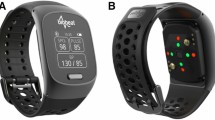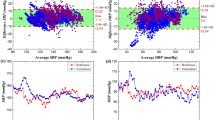Abstract
Pulse transit time (PTT) and pulse wave velocity (PWV), respectively, were shown to have a correlation with systolic blood pressure (SBP) and have been reported to be suitable for indirect BP measurements. The aim of this study was to create a function between SBP and PWV, and to test its reliability for the determination of absolute SBP using a non-linear algorithm and a one-point calibration. 63 volunteers performed exercise to induce rises in BP. Arterial PTT was measured between the R-spike of the ECG and the plethysmographic curve of finger pulse-oximetry. The reference BP was measured using a cuff-based sphygmomanometric aneroid device. Data from 13 of the 63 volunteers served for the detection of the PWV–BP relationship. The created non-linear function was used to calculate BP values after individual correction for the BP offset in a group of 50 volunteers. Individual correlation coefficients for SBP measured by PTT (SBPPTT) and by cuff (SBPCUFF) varied between r = 0.69 and r = 0.99. Taking all data together, we found r = 0.83 (276 measurements in 50 volunteers). In the Bland–Altman plot, the limits of agreement were \( {\text{mean}}_{{{\text{SBP}}_{\text{PTT}} , {\text{SBP}}_{\text{CUFF}} }} \)± 19.8 mmHg. In conclusion, comparing SBP values using the PTT-based method and those measured by cuff resulted in a significant correlation. However, the Bland–Altman plot shows relevant differences between both methods, which are partly due to greater variability of the SBPPTT measurement during intensified exercise. Results suggest that PTT can be used for measuring absolute SBP when performing an individual correction for the offset of the BP–PWV relation.




Similar content being viewed by others
References
Barschdorff D, Erig M (1998) [Continuous blood pressure monitoring during stress ECG] Kontinuierliche Blutdruckbestimmung wahrend des Belastungs-EKG. Biomed Tech (Berl) 43:34–39
Bartsch S, Ostojic D, Schmalgemeier H, Bitter T, Westerheide N, Eckert S, Horstkotte D, Oldenburg O (2010) Validation of continuous blood pressure measurements by pulse transit time: a comparison with invasive measurements in a cardiac intensive care unit. Dtsch Med Wochenschr 135:2406–2412
Bland JM, Altman DG (1986) Statistical methods for assessing agreement between two methods of clinical measurement. Lancet 1:307–310
Bland JM, Altman DG (1995) Calculating correlation coefficients with repeated observations: part 2—Correlation between subjects. BMJ 310:633
Brown MA, Reiter L, Smith B, Buddle ML, Morris R, Whitworth JA (1994) Measuring blood pressure in pregnant women: a comparison of direct and indirect methods. Am J Obstet Gynecol 171:661–667
Callaghan FJ, Babbs CF, Bourland JD, Geddes LA (1984) The relationship between arterial pulse-wave velocity and pulse frequency at different pressures. J Med Eng Technol 8:15–18
Campbell NR, Chockalingam A, Fodor JG, McKay DW (1990) Accurate, reproducible measurement of blood pressure. CMAJ 143:19–24
Chen W, Kobayashi T, Ichikawa S, Takeuchi Y, Togawa T (2000) Continuous estimation of systolic blood pressure using the pulse arrival time and intermittent calibration. Med Biol Eng Comput 38:569–574
Chen Y, Wen C, Tao G, Bi M, Li G (2009) Continuous and noninvasive blood pressure measurement: a novel modeling methodology of the relationship between blood pressure and pulse wave velocity. Ann Biomed Eng 37:2222–2233
Davies JI, Struthers AD (2003) Pulse wave analysis and pulse wave velocity: a critical review of their strengths and weaknesses. J Hypertens 21:463–472
Eckert S, Horstkotte D (2002) Comparison of Portapres non-invasive blood pressure measurement in the finger with intra-aortic pressure measurement during incremental bicycle exercise. Blood Press Monit 7:179–183
Foo JY, Lim CS (2006) Pulse transit time as an indirect marker for variations in cardiovascular related reactivity. Technol Health Care 14:97–108
Geddes LA, Voelz M, James S, Reiner D (1981) Pulse arrival time as a method of obtaining systolic and diastolic blood pressure indirectly. Med Biol Eng Comput 19:671–672
Hopkins WG (2004) Bias in Bland–Altman but not regression validity analyses. Sportscience 8:42–46
Imholz BP, Wieling W, van Montfrans GA, Wesseling KH (1998) Fifteen years experience with finger arterial pressure monitoring: assessment of the technology. Cardiovasc Res 38:605–616
Kermode JL, Davis NJ, Thompson WR (1989) Comparison of the Finapres blood pressure monitor with intra-arterial manometry during induction of anaesthesia. Anaesth Intensive Care 17:470–475
Kugler J, Rollnik J, Schmitz N (1997) Retest-reliability and convergent validity of noninvasive blood pressure determination: arm sphygmomanometry vs. Penaz-method. Int J Clin Monit Comput 14:251–254
Mitchell GF, Parise H, Benjamin EJ, Larson MG, Keyes MJ, Vita JA, Vasan RS, Levy D (2004) Changes in arterial stiffness and wave reflection with advancing age in healthy men and women: the Framingham Heart Study. Hypertension 43:1239–1245
Molhoek GP, Wesseling KH, Settels JJ, van Vollenhoven E, Weeda HW, de Wit B, Arntzenius AC (1984) Evaluation of the Penaz servo-plethysmo-manometer for the continuous, non-invasive measurement of finger blood pressure. Basic Res Cardiol 79:598–609
Muehlsteff J, Aubert XL, Schuett M (2006) Cuffless estimation of systolic blood pressure for short effort bicycle tests: the prominent role of the pre-ejection period. Conf Proc IEEE Eng Med Biol Soc 1:5088–5092
Nygaard HA (2008) Measuring body mass index (BMI) in nursing home residents: the usefulness of measurement of arm span. Scand J Prim Health Care 26:46–49
Ochiai R, Takeda J, Hosaka H, Sugo Y, Tanaka R, Soma T (1999) The relationship between modified pulse wave transit time and cardiovascular changes in isoflurane anesthetized dogs. J Clin Monit Comput 15:493–501
Payne RA, Symeonides CN, Webb DJ, Maxwell SR (2006) Pulse transit time measured from the ECG: an unreliable marker of beat-to-beat blood pressure. J Appl Physiol 100:136–141
Pruett JD, Bourland JD, Geddes LA (1988) Measurement of pulse-wave velocity using a beat-sampling technique. Ann Biomed Eng 16:341–347
R Development Core Team (2010) R foundation for statistical computing, Wien, Austria. http://www.R-project.org
Rebenson-Piano M, Holm K, Powers M (1987) An examination of the differences that occur between direct and indirect blood pressure measurement. Heart Lung 16:285–294
Schiffrin EL (2004) Vascular stiffening and arterial compliance. Implications for systolic blood pressure. Am J Hypertens 17:39S–48S
Turjanmaa V (1989) Determination of blood pressure level and changes in physiological situations: comparison of the standard cuff method with direct intra-arterial recording. Clin Physiol 9:373–387
Van Bergen FH, Weatherhead DS, Treloar AE, Dobkin AB, Buckley JJ (1954) Comparison of indirect and direct methods of measuring arterial blood pressure. Circulation 10:481–490
Versluis RG, Petri H, van de Ven CM, Scholtes AB, Broerse ER, Springer MP, Papapoulos SE (1999) Usefulness of armspan and height comparison in detecting vertebral deformities in women. Osteoporos Int 9:129–133
Wippermann CF, Schranz D, Huth RG (1995) Evaluation of the pulse wave arrival time as a marker for blood pressure changes in critically ill infants and children. J Clin Monit 11:324–328
Yamashina A, Tomiyama H, Arai T, Koji Y, Yambe M, Motobe H, Glunizia Z, Yamamoto Y, Hori S (2003) Nomogram of the relation of brachial–ankle pulse wave velocity with blood pressure. Hypertens Res 26:801–806
Zheng D, Murray A (2009) Non-invasive quantification of peripheral arterial volume distensibility and its non-linear relationship with arterial pressure. J Biomech 42:1032–1037
Acknowledgments
The authors thank Prof. P. Martus for his support in statistical analysis.
Conflict of interest
There are no conflicts of interest for the authors Heiko Gesche, Detlef Grosskurth, and Andreas Patzak. Gert Küchler holds the patent cited in the manuscript and is owner of the Somnomedics GmbH. There was no financial support from any company.
Author information
Authors and Affiliations
Corresponding author
Additional information
Communicated by Keith Phillip George.
Rights and permissions
About this article
Cite this article
Gesche, H., Grosskurth, D., Küchler, G. et al. Continuous blood pressure measurement by using the pulse transit time: comparison to a cuff-based method. Eur J Appl Physiol 112, 309–315 (2012). https://doi.org/10.1007/s00421-011-1983-3
Received:
Accepted:
Published:
Issue Date:
DOI: https://doi.org/10.1007/s00421-011-1983-3




